Animal Facts
Discover Birds of Pennsylvania: Feathered Wonders
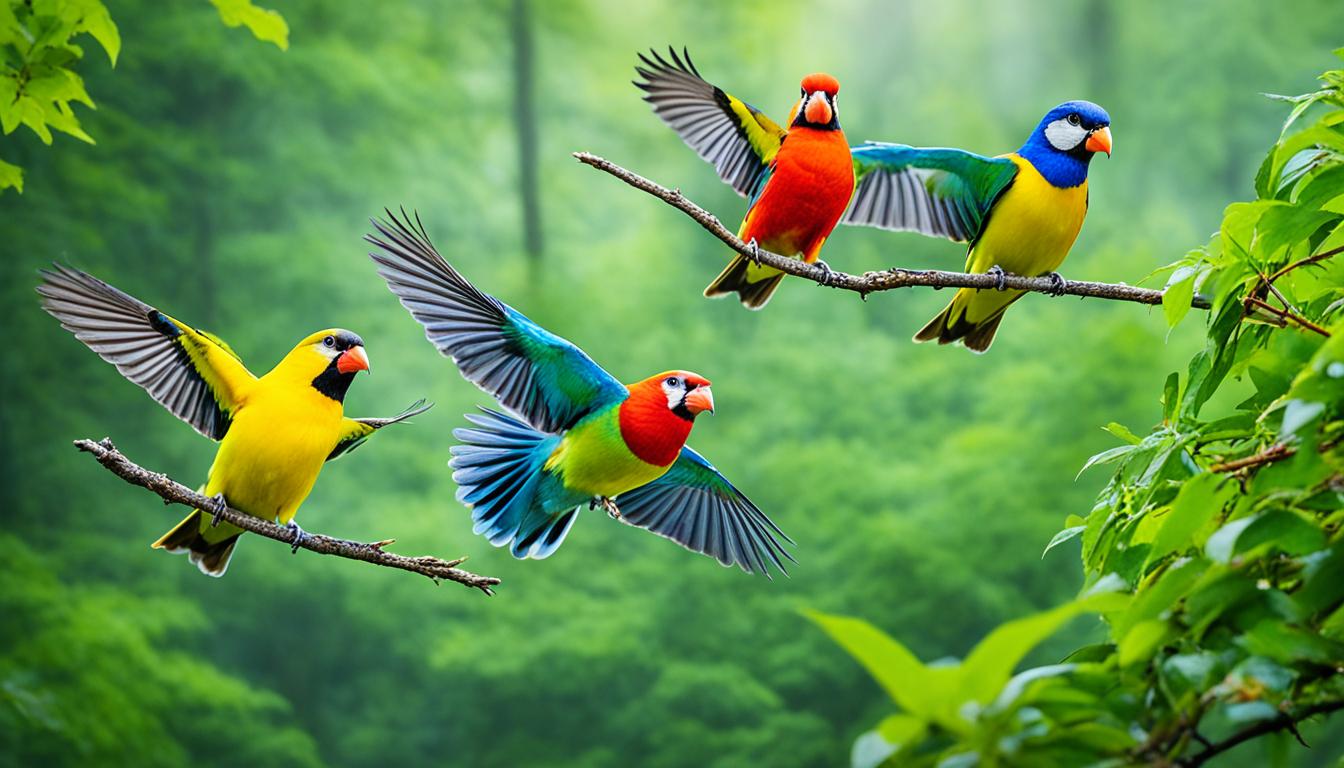
Did you know that Pennsylvania is home to an impressive 435 species of birds? With its diverse natural habitats covering over 46,000 square miles, Pennsylvania offers a birdwatcher’s paradise like no other. From the majestic Northern Cardinal to the charming American Robin, the state is teeming with fascinating feathered creatures waiting to be discovered.
Key Takeaways:
- Pennsylvania is home to 435 species of birds.
- The state’s diverse natural habitats make it a paradise for birdwatchers.
- The Northern Cardinal and American Robin are among the most common birds found in Pennsylvania.
- Each bird has unique characteristics that make it fascinating to observe and appreciate.
- Exploring the birds of Pennsylvania offers a rich and rewarding experience for nature enthusiasts.
Most common birds of Pennsylvania
When it comes to birdwatching in Pennsylvania, there are some birds that you are almost guaranteed to see. These common birds can be found throughout the state, from city parks to rural forests. We have compiled a list of the most commonly seen birds in Pennsylvania, based on the latest data from eBird sightings. Whether you are a seasoned birdwatcher or just starting out, knowing these species will enhance your birding experience in Pennsylvania.
- Northern Cardinal
- American Robin
- Blue Jay
- Mourning Dove
- American Crow
- Song Sparrow
- American Goldfinch
- Red-bellied Woodpecker
- Downy Woodpecker
Each bird on this list has its own unique features and behaviors that make it easily identifiable. Whether it’s the vibrant red plumage of the Northern Cardinal, the melodious song of the American Robin, or the bold blue feathers of the Blue Jay, these birds capture the essence of Pennsylvania’s diverse avian population.
To help you get better acquainted with these common birds, we have provided detailed information about their appearance, behavior, and unique characteristics. Whether you encounter them on a leisurely stroll in a local park or during an adventurous hike in the wilderness, these birds will surely capture your attention and spark a sense of wonder.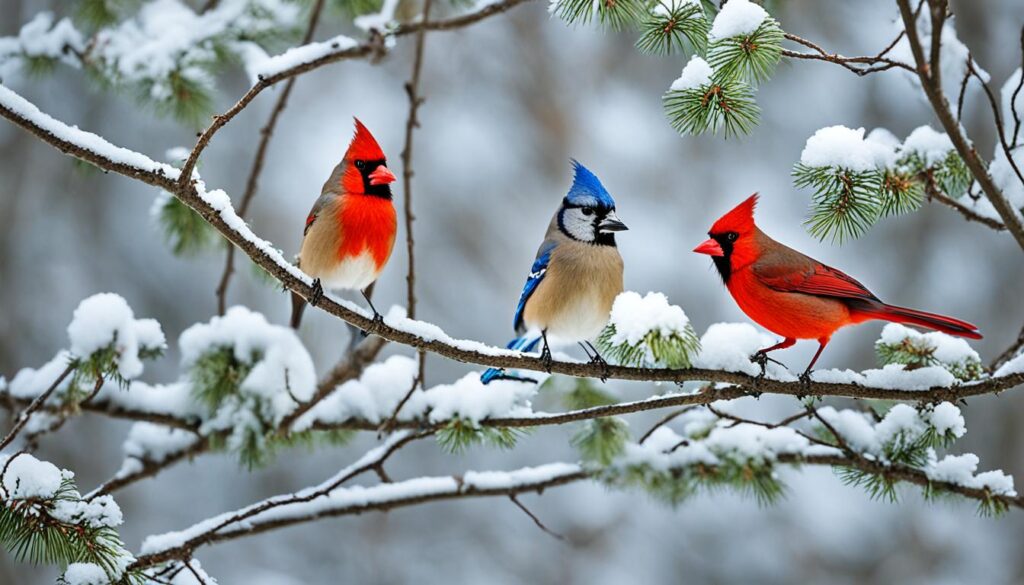
Observing and identifying these common birds of Pennsylvania can be a thrilling experience for birdwatchers of all levels. So grab your binoculars, head outdoors, and let the beauty of Pennsylvania’s feathered wonders unfold before your eyes.
Northern Cardinal
The Northern Cardinal, scientifically known as Cardinalis cardinalis, is a beautiful and commonly seen bird in Pennsylvania. Its vibrant red plumage makes it easily recognizable and a favorite among birdwatchers. In fact, this stunning bird holds the title of the state bird in seven different states!
But it’s not just the male cardinals that dazzle with their crimson feathers; female Northern Cardinals are also noteworthy. They possess a more subdued combination of gray and red tones, allowing them to blend in with their surroundings while still maintaining their elegant charm.
One interesting fact about Northern Cardinals is that both males and females are accomplished singers. While the males are known for their rich, melodic songs, the females also have their own unique repertoire. They use their vocalizations to communicate with their mates or to warn them of potential threats in their territory.
When observing a Northern Cardinal, you’ll notice its medium-sized build, measuring approximately 8.75 inches in length. This bird weighs around 1.6 ounces and has a wingspan of 12 inches, allowing it to glide effortlessly through the air.
| Description | Measurement |
|---|---|
| Length | 8.75 inches |
| Weight | 1.6 ounces |
| Wingspan | 12 inches |
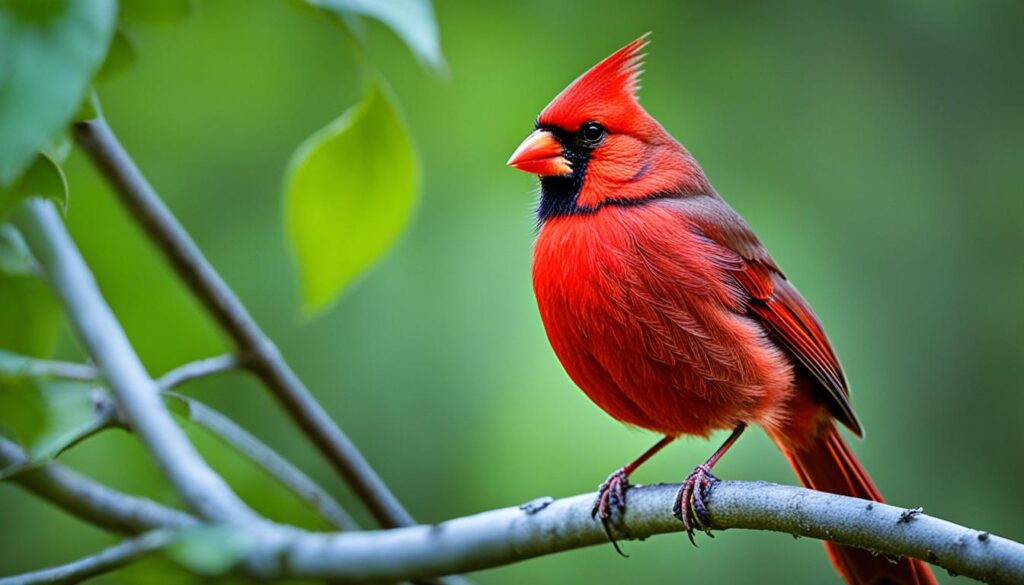
The Northern Cardinal’s beauty, melodious songs, and widespread presence make it a beloved bird not just in Pennsylvania but across its range. Keep an eye out for these stunning creatures during your birdwatching adventures, and don’t forget to listen to their enchanting songs that bring joy to nature enthusiasts everywhere.
American Robin
The American Robin is a popular bird in Pennsylvania, easily recognized by its dark gray upperparts and brick red and white underparts. It is the second most common bird in the state. These birds forage for worms and bugs on lawns and other open grassy areas, as well as eat berries. They measure about 10 inches in length, weigh 2.7 ounces, and have a wingspan of 17 inches.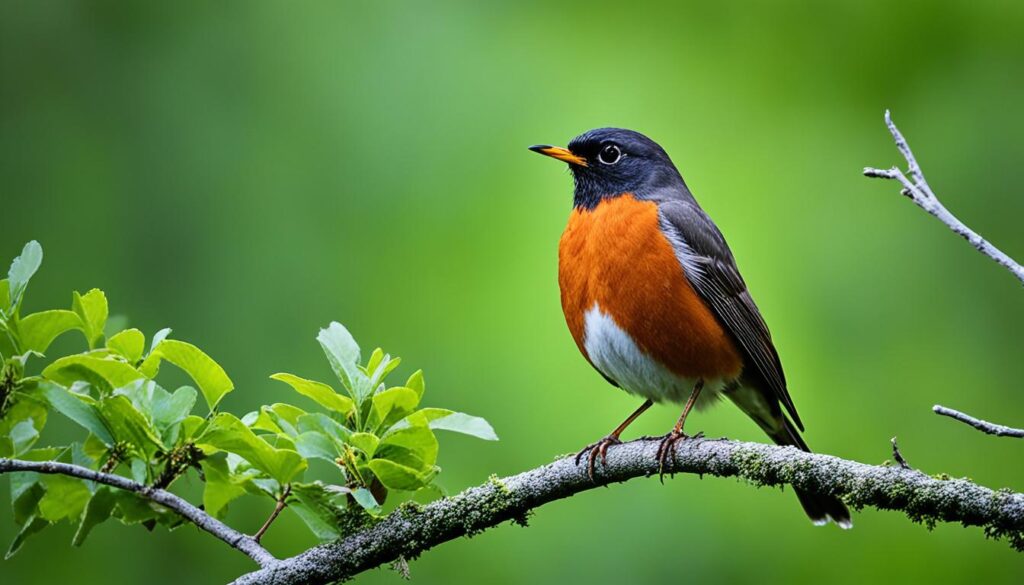
The American Robin, scientifically known as Turdus migratorius, is a familiar sight in Pennsylvania. This thrush species has become a symbolic harbinger of spring, with its arrival marking the changing season. The American Robin’s melodious song fills the air, adding a delightful soundtrack to the awakening of nature.
Characteristics of the American Robin
The American Robin boasts distinctive plumage that sets it apart. Its dark gray back and head contrast beautifully with its brick red breast and white belly. This colorful combination makes it relatively easy to identify. Additionally, robins have a vibrant yellow beak and a white ring around their eyes.
With their long legs, slender bodies, and strong wings, American Robins are well-suited for their foraging habits. They are known to hop and run across lawns, using their sharp eyesight to spot potential prey. The robins’ diet mainly consists of earthworms and insects, which they locate by sight or by listening for the sounds of prey moving underground.
| American Robin | |
|---|---|
| Length | Approximately 10 inches |
| Weight | Approximately 2.7 ounces |
| Wingspan | Approximately 17 inches |
These sociable birds are often seen in flocks during the winter months, which allows them to benefit from collective protection and enhanced foraging efficiency. As the weather warms, they disperse into pairs and begin nesting activities. American Robins are skilled architects, constructing sturdy cup-shaped nests made of twigs, debris, and mud. They tend to build their nests in trees, on ledges, or even on man-made structures such as porch lights or mailboxes.
Did you know? Despite its name, the American Robin is not a robin at all in the European sense. It belongs to the Thrush family and is closer in relation to the European Blackbird.
The American Robin’s mellow warbles and chirping melodies add joyous notes to Pennsylvania’s soundscape. Whether it’s their vibrant colors, delightful vocals, or their role as a sign of the changing seasons, American Robins hold a special place in the hearts of bird lovers and nature enthusiasts alike. So, keep an eye out for these cheerful, feathered visitors during your Pennsylvania birdwatching adventures.
Blue Jay
The Blue Jay is a common, intelligent, and noisy bird found in Pennsylvania. With its vibrant blue feathers, it is easily recognizable and adds a pop of color to any birdwatching experience. Blue Jays can be spotted foraging for food in trees and at feeders, often competing with other birds for their share.
Known for their raucous calls, Blue Jays make a variety of vocalizations to communicate with each other and establish their presence. Their distinctive “Nyeah! Nyeah! Nyeah!” call echoes through the trees, creating a unique and recognizable sound in the avian chorus.
Measuring approximately 11 inches in length with a weight of around 3 ounces, Blue Jays are medium-sized birds with a wingspan of 16 inches. Their compact yet strong build allows them to navigate through the trees with agility and precision.
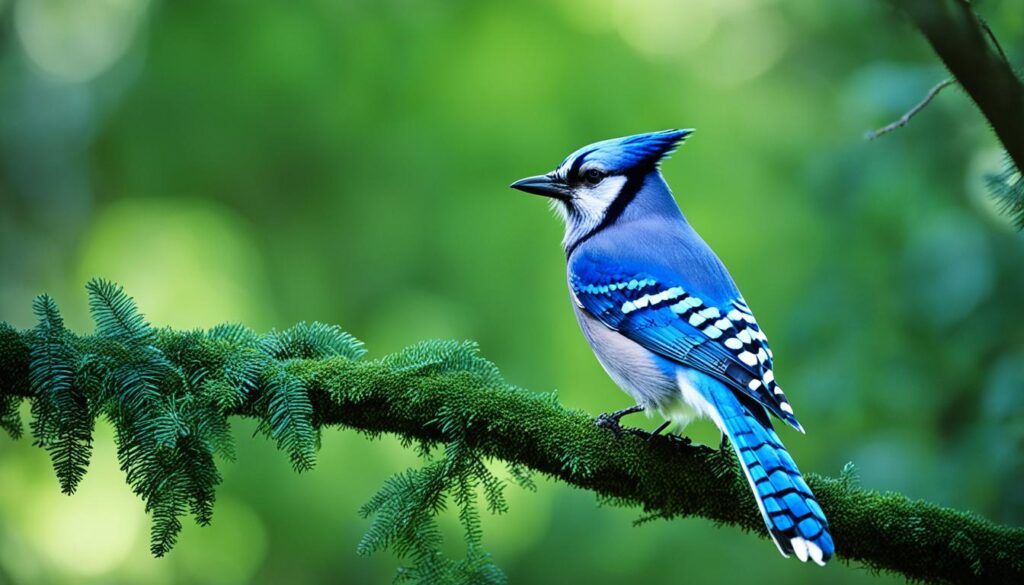
These intelligent birds are quick learners and have been known to mimic the calls of other bird species, as well as imitate human voices and sounds. Their inquisitive nature and ability to adapt to different environments have made them a favorite among birdwatchers in Pennsylvania.
“The Blue Jay’s vibrant blue plumage and lively presence bring joy to any birdwatching excursion.” – Birdwatching Enthusiast
Mourning Dove
Mourning Doves are a common sight in Pennsylvania, with their plain brown and gray feathers and long, pointed tails. These doves feed on seeds and can often be seen foraging on the ground in open areas. Their mournful cooing sound is often mistaken for an owl’s hoot. Mourning Doves measure about 12 inches in length, weigh 4.2 ounces, and have a wingspan of 18 inches.
| Species | Measurement | Weight | Wingspan |
|---|---|---|---|
| Mourning Dove | About 12 inches | 4.2 ounces | 18 inches |

The Mourning Dove, scientific name Zenaida macroura, is well-adapted to Pennsylvania’s diverse landscapes. Its subtle plumage helps it blend into its surroundings, while its long tail aids in agile flight. The mournful cooing of the Mourning Dove adds a melodic ambiance to the Pennsylvania sky.
American Crow
The American Crow, scientifically known as Corvus brachyrhynchos, is a large, all-black bird commonly found in Pennsylvania. With its distinctive appearance and vocal nature, the American Crow is easily recognizable and often catches the attention of birdwatchers.
This intelligent and adaptable bird is known for its wide range of vocalizations, but it is most recognized for its loud and distinctive “Caw! Caw!” call. This call can be heard echoing through the trees as the American Crow communicates with other crows in its flock or warns of potential threats.
The American Crow has a diverse diet and is highly opportunistic when it comes to foraging for food. It can be seen scavenging for carrion, feeding on fruit, seeds, insects, and even small animals. Their resourcefulness and ability to adapt to different environments have contributed to their success as a species.
American Crows are known to build bulky stick nests high in trees. These nests serve as their homes, providing shelter and protection for themselves and their young. They are skilled builders, creating sturdy structures that withstand challenging weather conditions.
With a length of about 17.5 inches, a weight of 1 pound, and an impressive wingspan of 39 inches, the American Crow stands out among other bird species in Pennsylvania. Its striking black feathers and strong presence make it a captivating bird to observe in its natural habitat.
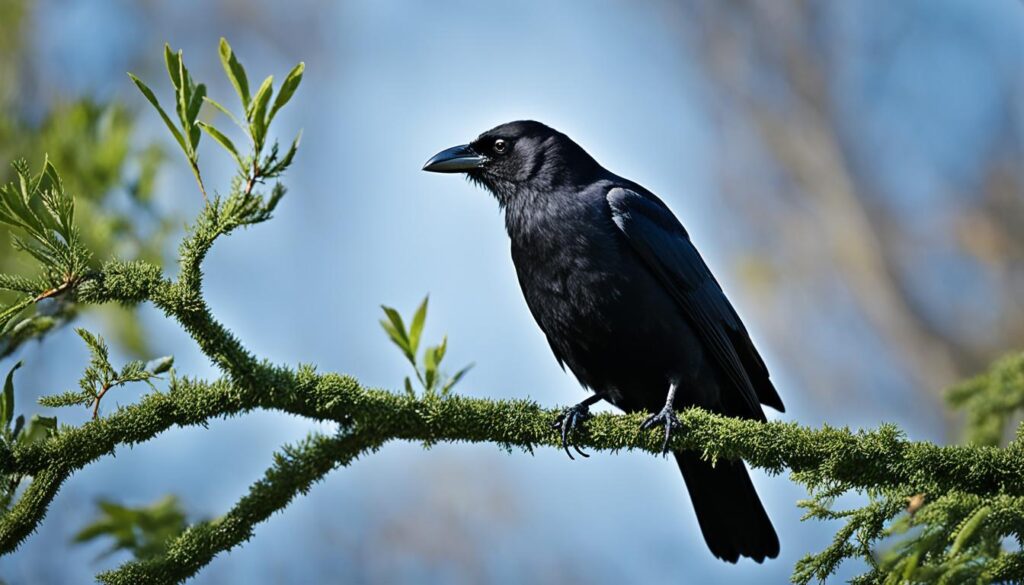
When encountering an American Crow, take a moment to appreciate its beauty and observe its behavior. Whether you spot it foraging for food or soaring through the sky, the American Crow is a fascinating bird that adds to the diverse avian population of Pennsylvania.
Song Sparrow
The Song Sparrow is a charming little bird that can be easily spotted in Pennsylvania’s brushy habitats. These small sparrows are typically brown with streaked patterns on their feathers, allowing them to blend seamlessly with their surroundings. They are known for their melodious song, which is a delightful addition to the sounds of nature.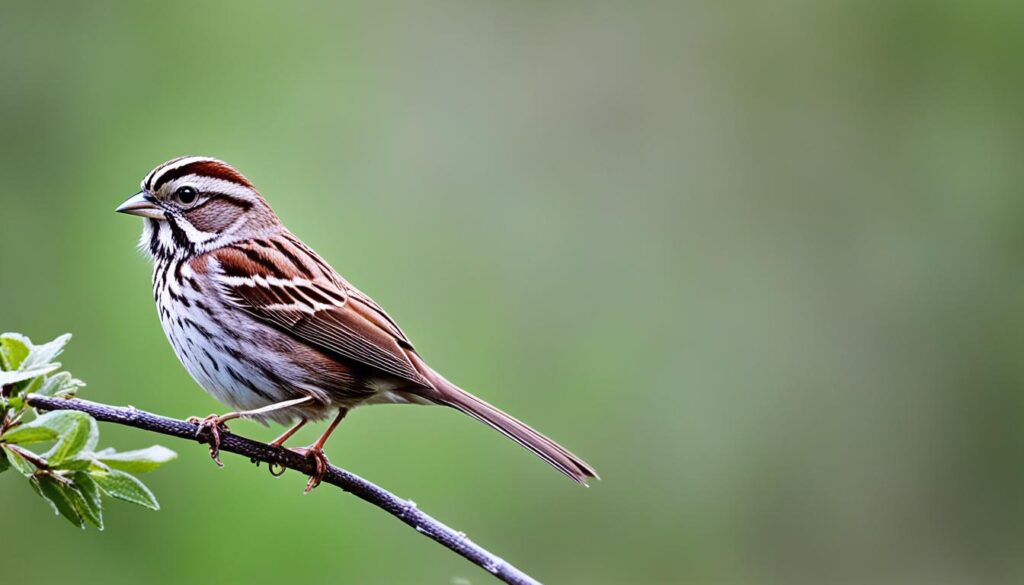
Song Sparrows are opportunistic feeders, foraging for seeds and insects on or near the ground. Their preferred habitats include fields, wetlands, and the edges of forests, where they can find ample food and cover. These versatile sparrows are also adept at adapting to suburban areas and can often be found in gardens and parks.
Building cup-shaped nests on or near the ground, typically in shrubs or low trees, is a common practice for Song Sparrows. These nests provide protection for their eggs and young while also being conveniently located for easy access to food sources.
Measuring approximately 6.25 inches in length and weighing around 0.7 ounces, these tiny sparrows have a wingspan of about 8.25 inches. Despite their small size, Song Sparrows contribute significantly to the bird population of Pennsylvania, adding their unique beauty and enchanting songs to the state’s avian diversity.
American Goldfinch
Discover the beauty of the American Goldfinch, a small and vibrant finch species that is a delightful sight in Pennsylvania’s weedy fields, parks, and backyards. With its bright yellow plumage, this finch is easily recognizable and adds a splash of color to its surroundings.
The American Goldfinch is known for its diet consisting primarily of seeds from various low plants and trees. They also visit feeders, where they can often be seen perched while enjoying their meal. Their preference for seeds makes them especially fond of sunflowers, dandelions, thistles, and other plants that produce tiny seeds.
When it comes to nesting, American Goldfinches show remarkable craftsmanship. They construct tightly woven cup nests high in shrubs or low trees, using plant fibers, moss, and spider silk. Their nests are so secure and tightly woven that they can hold water without leaking. This adaptation helps protect the eggs and nestlings during heavy rain.
This finch measures about 5 inches in length, weighs 0.46 ounces, and possesses a wingspan of 9 inches. Despite their small size, American Goldfinches are agile flyers and are often seen gracefully flitting from one location to another.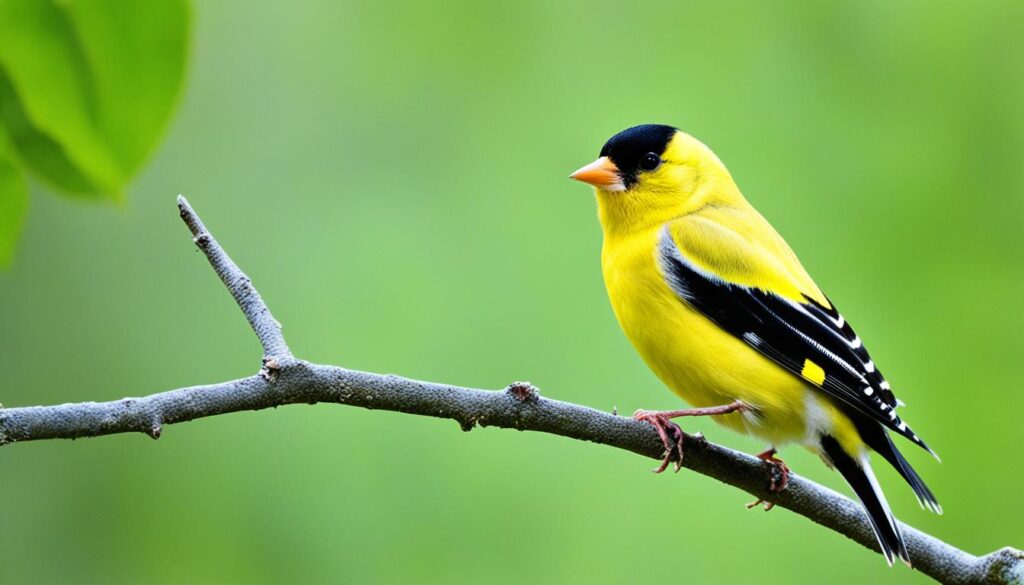
| Measurement | Value |
|---|---|
| Length | 5 inches |
| Weight | 0.46 ounces |
| Wingspan | 9 inches |
If you want to attract American Goldfinches to your backyard, consider planting native plants that produce small seeds. Providing thistle or nyjer feeders can also entice them to visit regularly.
The American Goldfinch is a true delight for birdwatchers, capturing our attention with its vibrant colors and aerial acrobatics. Spotting these cheerful finches adds a touch of brightness to any birding expedition and brings joy to all who appreciate the wonders of nature.
Red-bellied Woodpecker
The Red-bellied Woodpecker (Melanerpes carolinus) is a common and adaptable bird found throughout Pennsylvania. With its striking plumage and unique behavior, it is a favorite among birdwatchers. Let’s delve into the fascinating world of the Red-bellied Woodpecker and discover why it captivates the hearts of many nature enthusiasts.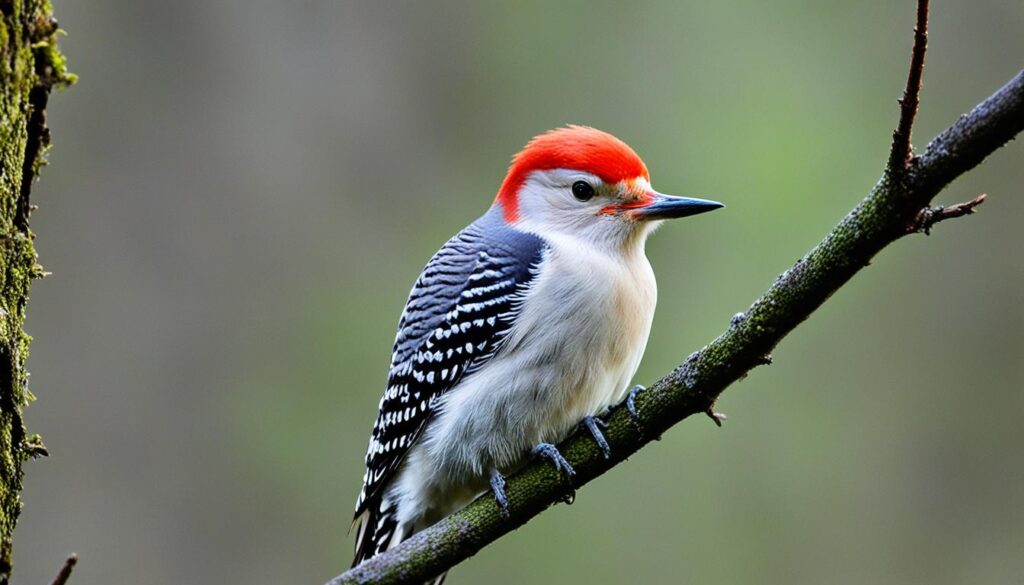
Foraging and Feeding
The Red-bellied Woodpecker is known for its versatile diet, which includes seeds, nuts, insects, and other small creatures. It uses its strong bill to peck into tree trunks and branches, searching for hidden food sources. This woodpecker also has a unique feeding behavior – it can extend its long tongue up to two inches past the tip of its bill, allowing it to extract insects from crevices in the wood.
Nesting and Habitat
These woodpeckers nest in tree cavities, often creating new openings each year. They prefer habitats with a mix of large trees and open spaces. Forests, woodlands, and suburban areas provide suitable environments for nesting and foraging. The Red-bellied Woodpecker also has a preference for dead trees, as they offer excellent opportunities for cavity excavation.
The Call of the Red-bellied Woodpecker
If you’re out in the woods and hear a distinct “Qwerr!” call, chances are it’s the Red-bellied Woodpecker. This vocal bird uses its call to communicate with others, mark its territory, or signal a potential threat. Once you become familiar with its unique call, you’ll be able to spot this woodpecker more easily.
The Red-bellied Woodpecker, with its vibrant colors and lively behavior, adds a touch of excitement to any birdwatching experience. Its adaptability to various habitats and resourceful foraging techniques make it one of Pennsylvania’s most intriguing avian residents.
Quick Facts about the Red-bellied Woodpecker:
- Length: Approximately 9.25 inches
- Weight: Around 2.2 ounces
- Wingspan: Approximately 16 inches
- Feeding habits: Forages for seeds, nuts, insects, and other food on tree trunks and branches
- Nesting behavior: Creates cavities in trees for nesting and prefers habitats with a mix of large trees and open spaces
- Distinctive call: Characterized by a “Qwerr!” call for communication and territorial marking
Downy Woodpecker
The Downy Woodpecker, scientifically known as Dryobates pubescens, is a fascinating species of woodpecker found in North America. Despite its small size, it is widely distributed and highly adaptable, making it a common sight in various habitats.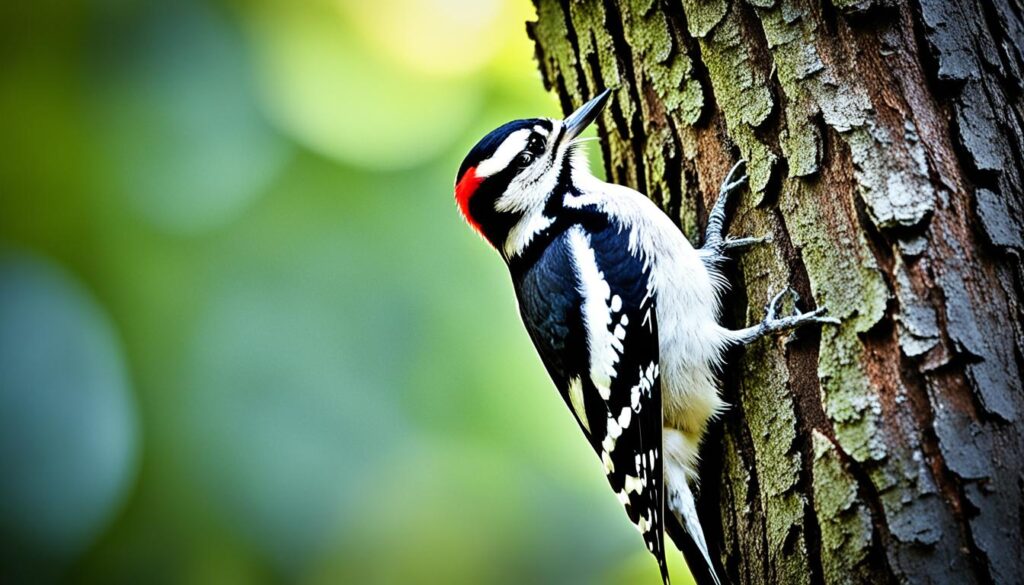
Downy Woodpeckers typically measure about 6.75 inches in length, weigh 0.95 ounces, and have a wingspan of 12 inches. While they may be the smallest woodpecker in North America, they are certainly not lacking in charm or character.
These woodpeckers are known for their distinctive black and white plumage, with a white belly, black wings adorned with white spots, and a black tail. The male features a small red patch on the back of its head, while the female lacks this feature.
One of the remarkable traits of the Downy Woodpecker is its ability to forage for insects, seeds, and suet both on trees and bushes as well as at feeders. They use their specially adapted bill to drum on tree trunks and probe for food, taking advantage of their strong grip and short tail for balance.
Downy Woodpeckers are cavity nesters, making use of natural or excavated tree cavities to create their nests. They are skilled architects, shaping their homes to suit their needs and providing a safe environment for raising their young.
When it comes to vocalizations, these woodpeckers communicate through a sharp “pik!” call, which is often followed by a drumming sound. This percussive drumming serves various purposes, including territory defense and courtship displays.
| Size | Weight | Wingspan |
|---|---|---|
| 6.75 inches | 0.95 ounces | 12 inches |
If you’re fortunate enough to spot a Downy Woodpecker during your birdwatching adventures, take a moment to appreciate its delicate size and intricate patterns. These charming birds are a testament to the beauty and diversity of nature.
Conclusion
Pennsylvania is a true haven for birdwatchers, offering an incredible variety of bird species and diverse habitats to explore. From the striking beauty of the Northern Cardinal to the lively antics of the Blue Jay, each bird contributes its own special charm to the vibrant avian tapestry of the state.
Whether you’re an avid birdwatcher or simply enjoy immersing yourself in the wonders of nature, Pennsylvania’s birds will never cease to captivate you. With binoculars in hand, venture out to discover the rich array of feathered creatures that call this state home, and embark on a truly unforgettable journey.
From the tranquil forests to the bustling wetlands, Pennsylvania’s diverse habitats provide the perfect backdrop for birdwatching enthusiasts to witness the marvels of nature. Whether you’re marveling at the breathtaking colors of the Northern Cardinal or admiring the intelligence of the Blue Jay, every bird encounter in Pennsylvania is a testament to the remarkable beauty and diversity found in our feathered friends.FAQ
What are the most common birds found in Pennsylvania?
What is the Northern Cardinal?
What is the American Robin?
What is the Blue Jay?
What is the Mourning Dove?
What is the American Crow?
What is the Song Sparrow?
What is the American Goldfinch?
What is the Red-bellied Woodpecker?
What is the Downy Woodpecker?
As our Editor-in-Chief, James plays a pivotal role in ensuring the quality and integrity of our content. With a keen eye for detail and a passion for storytelling, James oversees the editorial process here at A Place for Animals. With years of experience in content editing, James ensures that every piece of content meets our high standards of accuracy and clarity. Under James’ guidance, you can rest assured that the content you read is informative and impeccably crafted.
Animal Facts
5 Fascinating Animals Without Tails
Get ready to explore the world of tailless wonders with gorillas, chimpanzees, and more mysterious creatures that will leave you in awe.
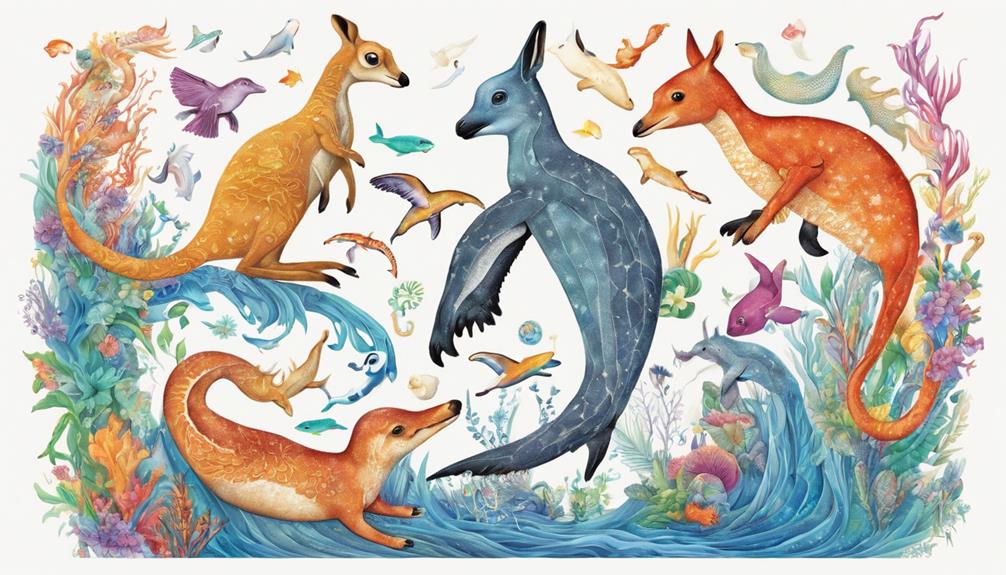
Prepare to be impressed by animals that break the norm by thriving without tails. From tailless primates such as gorillas and chimpanzees with intricate social structures to intelligent dolphins displaying their playful nature, these creatures are sure to captivate your attention.
Pangolins covered in protective scales and facing endangerment, gentle manatees gracefully traversing waters, and spiders showcasing intricate adaptations are also part of this tailless wonders list. Stay tuned to discover more fascinating details about these incredible tailless animals.
Key Takeaways
- Dolphins are highly intelligent creatures with no tails, known for complex problem-solving skills and communication abilities.
- Pangolins, covered in protective scales, face extinction due to illegal poaching, making conservation efforts crucial.
- Manatees, gentle herbivores without tails, are vulnerable to threats like boat strikes and habitat loss, requiring protection.
- Spiders, diverse arachnids, use silk for web-building and prey capture, showcasing unique adaptations and intricate behaviors.
- Primates like gorillas and chimpanzees are tailless, displaying remarkable intelligence and complex social behaviors.
Primates
In the domain of tailless animals, primates stand out for their remarkable intelligence and intricate social dynamics. Tailless primates, such as gorillas, chimpanzees, bonobos, and orangutans, showcase a myriad of complex social behaviors that mirror our own. The absence of a tail in primates has driven their evolution towards bipedal locomotion, allowing for upright posture, which has further facilitated their tool use for problem-solving. These fascinating creatures have adapted to diverse environments in Africa and Southeast Asia, demonstrating their resilience and versatility.
Among the tailless primates, gibbons are particularly known for their acrobatic abilities and distinctive vocalizations in the wild. Their swinging prowess through the treetops is a sight to behold. Additionally, primates without tails engage in various behaviors, from intricate grooming rituals that strengthen social bonds to establishing complex social hierarchies within their groups. Observing these intelligent creatures navigate their social worlds offers a glimpse into the intricate tapestry of relationships and behaviors that define their existence.
Dolphins

Dolphins, renowned for their intelligence and social nature, possess a unique horizontal fluke for propulsion instead of a visible external tail. These marine mammals exhibit intriguing behavior and engage in intricate social interactions that fascinate observers worldwide.
Here are some fascinating facts about dolphins:
- Dolphins are highly intelligent creatures, displaying complex problem-solving skills and communication abilities.
- Their playful behavior often involves riding waves, leaping out of the water, and engaging in games with other dolphins.
- Social interactions among dolphins are essential for their survival, as they rely on cooperation and communication within their pod.
- The horizontal fluke of dolphins serves as a powerful propulsion mechanism, allowing them to move swiftly and gracefully through the water.
Through the combination of their streamlined bodies, powerful muscles, and unique fluke structure, dolphins showcase efficient swimming techniques and remarkable acrobatic prowess, making them truly captivating marine animals.
Pangolins
Gracefully gliding through their habitats, pangolins captivate with their unique features and behaviors. These unique mammals are covered in protective keratin scales, making them resemble walking artichokes. Their long, sticky tongues are perfectly adapted for capturing ants and termites, their favorite delicacies.
Unfortunately, pangolins are facing a grave threat – illegal poaching. The demand for their scales and meat has pushed them to the brink of extinction, with all eight species, spread between Africa and Asia, endangered.
Conservation efforts are paramount in safeguarding these fascinating creatures. Initiatives to combat the illegal wildlife trade are essential for the survival of pangolins. Raising awareness about the plight of these gentle animals is vital, as is enforcing stricter laws to protect them. Without immediate action, pangolins may disappear from the wild forever.
It's up to us to make sure that these marvelous creatures continue to roam our forests and savannas, adding their unique charm to the tapestry of nature.
Manatees

Swimming gracefully through the coastal waters and rivers of tropical and subtropical regions, manatees, also known as sea cows, are large, herbivorous marine mammals with distinctive paddle-like flippers and a rounded, tailless body shape. These gentle giants captivate with their unique features and behaviors:
- Gentle Herbivores: Manatees have a peaceful nature, feeding on aquatic plants in their watery habitats.
- Slow-Moving Giants: Despite their size, manatees move gracefully and slowly through the water.
- Vulnerable Creatures: Due to their gentle demeanor and slow movements, manatees are susceptible to threats like boat strikes.
- Conservation Concerns: Ongoing efforts to protect manatees and their habitats from dangers like habitat loss and human activities.
Manatees, with their endearing characteristics and vulnerable status, remind us of the importance of safeguarding these magnificent marine mammals through dedicated conservation initiatives.
Spiders
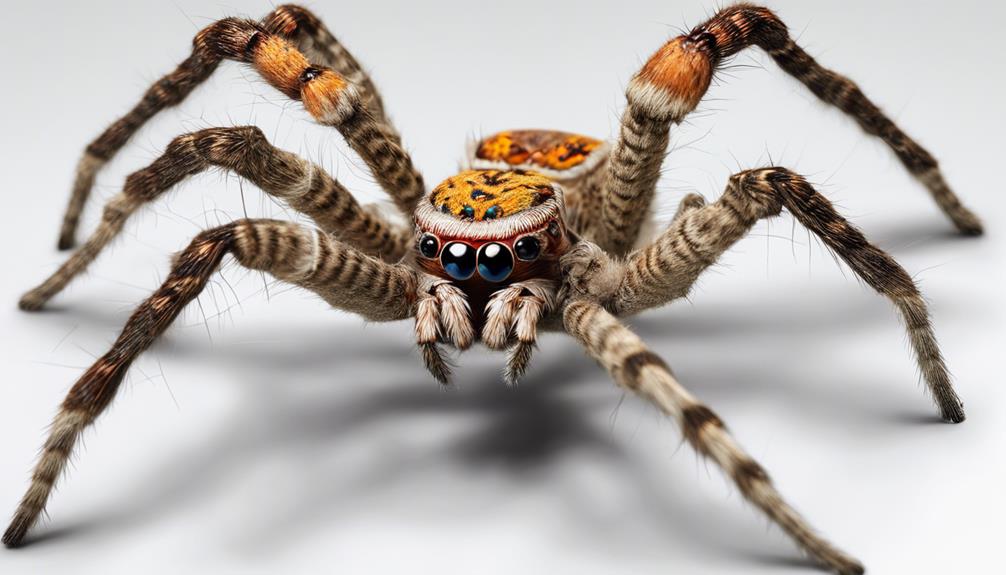
Intriguing for their arachnid characteristics, spiders captivate with their diverse species and unique adaptations for survival in various habitats.
Spiders, belonging to the arachnid family, are renowned for their eight legs and the absence of a tail. They produce silk for various purposes, including web-building, prey capture, and constructing shelters. Utilizing venom to subdue their prey, spiders possess specialized hunting techniques that vary among species.
Some spiders exhibit intricate mating behaviors and display remarkable parental care, a surprising trait for creatures often associated with solitude. Despite their lack of a tail, spiders thrive in diverse environments, showcasing a remarkable array of adaptations.
From the intricate webs of orb-weavers to the stealthy ambush tactics of jumping spiders, each species contributes uniquely to the intricate tapestry of the natural world. The world of spiders is a fascinating domain where survival, reproduction, and innovation intersect in enthralling ways.
Frequently Asked Questions
What Kind of Animals Have No Tails?
We explore tailless animals like snakes, turtles, birds, apes, and whales. Taillessness can stem from various reasons like evolution, specialized movement, balance needs, environment factors, or survival benefits. These creatures display unique traits and habitats.
What Animal Has 4 Legs but No Tail?
We found an animal that has four legs but no tail. It's the Manx cat! This unique breed boasts a genetic mutation giving it a tailless charm. Despite lacking a tail, Manx cats are playful, affectionate, and agile.
Why Capybara Doesn T Have a Tail?
We don't have tails because we're capybaras, adapted herbivores thriving in wetlands. Our taillessness is natural, not a mutation or injury. We use strong social bonds and swimming skills to compensate effectively.
What Rodent Does Not Have a Tail?
It's common knowledge that the Tiliqua rugosa, a captivating rodent indigenous to Australia, lacks a tail. However, this tailless skink's distinctive adaptation of utilizing its stubby tail as a fat reserve demonstrates its incredible survival skills and adaptability.
Are Any of the Animals Without Tails in the List of Nature’s Oddities?
When unveiling nature’s oddities, it’s interesting to note that some animals are indeed tailless. Examples include the Manx cat, some breeds of dogs such as the Australian Stumpy Tail Cattle Dog, and certain species of lizards and insects. These tailless creatures definitely stand out in the animal kingdom.
Conclusion
To sum up, these tail-less creatures showcase the diverse adaptations found in the animal kingdom.
From the agile primates swinging through trees to the graceful dolphins gliding through the water, each species has evolved unique ways to thrive without a tail.
Observing these fascinating animals in their natural habitats provides a vivid glimpse into the intricate web of life on Earth, where every creature plays a crucial role in the ecosystem's balance.
Paul’s love for animals knows no bounds. As a dedicated writer and animal lover, Paul brings a unique perspective to our team. His firsthand experiences with various animals enrich our content and provide valuable insights into their behavior and needs. Whether he’s sharing tips for pet care or shedding light on pressing conservation issues, Paul’s passion for animals shines through in everything he does.
Animal Facts
Animals That Live in a Lake: Exploring Aquatic Wildlife
Prepare to be captivated by the diverse and colorful aquatic wildlife in lakes, from graceful pelicans to mysterious pike – a fascinating world awaits!

We discovered a range of fascinating aquatic animals that thrive in lakes. Among them are the adaptable ducks with webbed feet, the crucial lake trout in North American ecosystems, and the vibrant flamingos that add color to lakeshores. These creatures are important for biodiversity and help to keep the delicate balance of freshwater environments.
Explore further to uncover more about the enchanting wildlife that calls lakes home.
Key Takeaways
- Ducks with webbed feet are well-adapted to lake life.
- Lake trout are crucial in North American lake food chains.
- Salamanders play a significant role in lake ecosystems.
- Flamingos bring colorful beauty to lakeshores.
- Lakes host a diverse array of thriving freshwater life.
Freshwater Lake Animals
Freshwater lakes harbor a remarkable diversity of aquatic fauna, encompassing 41% of fish species and a myriad of unique animals such as beavers, frogs, electric eels, hurons, and dragonflies.
These animals play essential roles in the freshwater ecosystem, each adapted to live in the specific conditions provided by the lakes. Fish species like trout and bass thrive in the clear waters, while beavers construct intricate dams that shape the landscape.
Frogs can be spotted near the water's edge, their calls echoing through the tranquil surroundings. Electric eels, though elusive, add a spark to the underwater world with their unique abilities.
Hurons, with their graceful movements, navigate the waters effortlessly, preying on smaller fish. Dragonflies flit about, adding splashes of color to the lakeside scenery. Together, these animals create a vibrant tapestry of life within freshwater lakes, highlighting the intricate interconnectedness of this aquatic habitat.
Saltwater Lake Animals

In saltwater lakes, an array of fish species, such as clownfish, grouper, and pufferfish, thrives amidst the crucial salinity environment, showcasing unique adaptations for survival. These creatures have evolved specialized mechanisms to regulate their internal salt levels, enabling them to live in waters that would be inhospitable to many other freshwater animals. The table below highlights some of the fascinating saltwater lake animals and their distinctive features:
| Saltwater Lake Animals | Unique Adaptations | Habitat |
|---|---|---|
| Clownfish | Ability to live among sea anemones | Coral reefs |
| Grouper | Camouflaging techniques | Rocky crevices |
| Pufferfish | Inflating when threatened | Sandy bottoms |
Saltwater lakes provide crucial ecosystems for these fish species and many others, contributing to the rich marine biodiversity found in these unique habitats. The interactions between these animals and their environment shape the delicate balance of life in saltwater and freshwater habitats, highlighting the importance of preserving these aquatic ecosystems for future generations.
Semiaquatic Animals
Semiaquatic animals, encompassing amphibians, reptiles, and select mammals, navigate their existence in both terrestrial and aquatic domains, showcasing a diverse array of adaptations tailored to their dual habitat lifestyle.
River otters, with their streamlined bodies and webbed feet, elegantly glide through freshwater habitats, preying on fish and crustaceans while also foraging on land.
Painted turtles, known for their colorful shells, bask on logs in the sun to regulate body temperature before gracefully swimming to hunt for aquatic plants and small invertebrates.
Water snakes, equipped with bony plates for buoyancy and powerful muscles for swimming, stealthily patrol the shallows, preying on fish and amphibians.
Aquatic salamanders, such as the spotted salamander, exhibit fascinating larval stages in water before metamorphosing into adults that navigate both land and water, contributing to the intricate food webs of lake ecosystems.
These semiaquatic species play crucial roles in maintaining the delicate balance of freshwater ecosystems, highlighting the interconnectedness of life both above and below the water's surface.
Animals That Live in a Lake

Ducks, lake trout, salamanders, flamingos, and various other species populate lakes worldwide, forming diverse and intricate ecosystems. Ducks, with their distinctive webbed feet, are well-adapted to freshwater habitats. Lake trout, known for their pivotal role in the food chain of North American lakes. Salamanders, often overlooked, contribute substantially to the balance of lake ecosystems by regulating insect populations and serving as prey for larger predators. In contrast, flamingos add a splash of color to lakeshores, feasting on small crustaceans with their uniquely curved bills.
These aquatic wildlife species showcase the rich tapestry of life that thrives in freshwater environments. Each species holds a specific place within the intricate web of interactions that sustain the delicate balance of lake ecosystems. From the graceful movements of ducks gliding across the water to the stealthy hunt of lake trout lurking in the depths, these diverse inhabitants collectively shape the dynamic nature of lakes around the world.
What Do Animals That Live in Lakes Eat?

Among the diverse array of animals inhabiting lakes worldwide, their dietary preferences encompass a wide range of foods, including:
- Fish: Predatory fish such as pike and bass dominate the food chain, preying on smaller fish and invertebrates for sustenance. These important fish species play a critical role in regulating the lake's ecosystem by controlling the population of other aquatic creatures.
- Insects: Various insects serve as a crucial food source for many lake-dwelling animals, including fish, birds, and amphibians. Mosquito larvae, for example, are a favorite snack for fish like bass, contributing to the delicate balance of the lake's food web.
- Aquatic Plants: Herbivorous animals like ducks and swans rely on aquatic plants and algae as their primary diet. Grazing on these plant species not only sustains these herbivores but also helps in controlling the growth of vegetation within the lake.
- Small Mammals: Some lakes are home to small mammals like muskrats and otters that feed on a variety of foods, including fish, crustaceans, and aquatic plants. These omnivorous creatures play a significant role in shaping the biodiversity of the lake environment.
Frequently Asked Questions
What Type of Animals Live in the Lake?
We observe a variety of animals in lakes – from fish like trout and pike to diverse wildlife such as beavers, ducks, and dragonflies. These creatures interact within the lake ecosystem, showcasing a delicate balance of life.
What Are the Animals That Live in the Water?
In the water, we find a diverse array of animals such as fish, turtles, and frogs. They thrive in aquatic environments, adapting to the challenges and opportunities presented by lakes, rivers, and oceans.
What Kind of Marine Life Lives in Lake Michigan?
In Lake Michigan, over 30 fish species like lake trout, salmon, and yellow perch thrive. The ecosystem also includes freshwater mussels, crayfish, and algae. Birds such as seagulls, ducks, and cormorants contribute to the lake's biodiversity. Invasive species like zebra mussels and round gobies impact the native marine life.
What Kind of Animals Live in a Pond?
In ponds, diverse creatures like frogs, turtles, dragonflies, and fish thrive. Birds, including ducks and herons, flock for food and nesting. Aquatic plants offer shelter and sustenance. Ponds, akin to bustling cities, teem with life, interconnected in a delicate ecosystem.
What Kind of Aquatic Wildlife Can Be Found in Mountain Lakes?
When exploring mountain lakes, you might spot a variety of aquatic creatures. From elusive freshwater fish like the golden trout to amphibians like the American dipper, the alpine mountain wildlife guide is filled with fascinating creatures. Keep an eye out for otters, beavers, and even rare dragonflies in these high altitude lakes.
Conclusion
To sum up, the diverse array of animals that live in lakes showcases the incredible adaptability and resilience of aquatic wildlife.
From freshwater to saltwater environments, these creatures have evolved unique characteristics to thrive in their watery habitats.
By understanding what these animals eat and how they interact with their surroundings, we can gain a deeper appreciation for the intricate ecosystem of lakes and the crucial role these creatures play in maintaining balance and harmony within their underwater world.
Paul’s love for animals knows no bounds. As a dedicated writer and animal lover, Paul brings a unique perspective to our team. His firsthand experiences with various animals enrich our content and provide valuable insights into their behavior and needs. Whether he’s sharing tips for pet care or shedding light on pressing conservation issues, Paul’s passion for animals shines through in everything he does.
Animal Facts
What Animal Looks Most Like a Squirrel?
Uncover fascinating creatures resembling squirrels, from chipmunks to marmots and prairie dogs, showcasing unique similarities and connections in the animal kingdom.
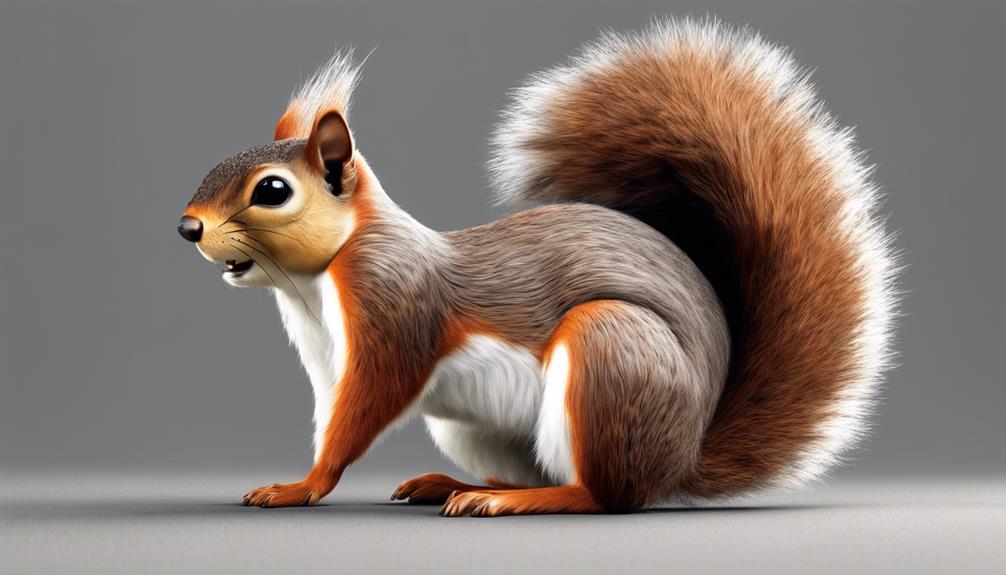
When searching for animals that resemble squirrels, creatures such as chipmunks, marmots, and prairie dogs are among the top contenders. Chipmunks are small with striped patterns and bushy tails, famous for storing food like squirrels. Marmots are larger ground-dwelling rodents with furry coats and bushy tails, some growing up to 2 feet in size. Prairie dogs, especially the Black-tailed and Gunnison’s species, with their underground burrows and social nature, also display squirrel-like features. These animals demonstrate behaviors and physical traits similar to squirrels, highlighting their interconnectedness in ecosystems.
If you're intrigued by these similarities, there's more to uncover about other rodents resembling squirrels and exotic pets with squirrel-like features.
Key Takeaways
- Chipmunks share squirrel-like features with distinctive stripes and bushy tails.
- Marmots resemble squirrels in size and bushy tails, with burrowing habits.
- Black-tailed Prairie Dogs exhibit squirrel-like characteristics in appearance and behavior.
- Rodents like marmots, chipmunks, and prairie dogs show similarities to squirrels.
- Exotic pets like Sugar Gliders and Chinchillas have features akin to squirrels for unique options.
Chipmunks: The Squirrel Lookalikes
Chipmunks, small rodents closely resembling squirrels in appearance and behavior, exhibit a striking resemblance that extends beyond their physical attributes to their nesting habits and foraging techniques. These creatures, part of the squirrel family, boast bushy tails and distinctive striped patterns akin to tree squirrels. While their tails are shorter, chipmunks share the squirrel's propensity for food caching, storing nuts and seeds for later consumption. Nest builders by nature, some chipmunk species, such as the Lodgepole Chipmunk, construct intricate burrows for shelter and protection.
What sets chipmunks apart is their adept climbing skills, effortlessly maneuvering through trees much like their squirrel cousins. Observing these small mammals scurrying up branches with agility is a reflection of their evolutionary adaptations. The similarities between chipmunks and tree squirrels aren't merely superficial; they run deep in their genetic makeup and behavioral patterns. Studying these tiny creatures provides a fascinating glimpse into the interconnectedness of nature within the squirrel family.
Marmots: Nature's Squirrel Twins
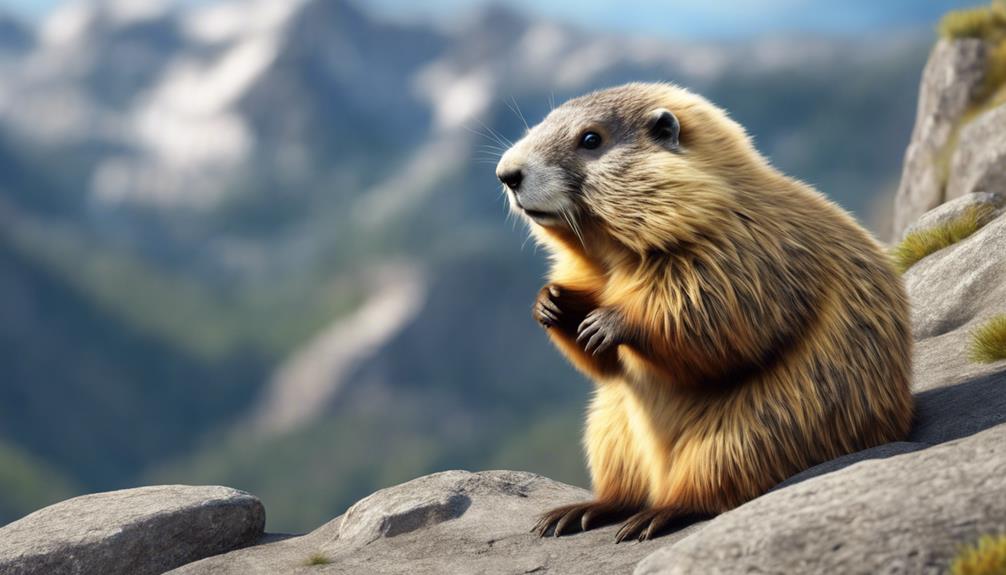
Closely resembling squirrels in appearance and behavior, marmots are larger ground-dwelling rodents known for their furry coats and bushy tails. These creatures, akin to tree squirrels, exhibit striking physical similarities, making them nature's squirrel twins.
Marmots, with their penchant for constructing underground burrows like their squirrel counterparts, engage in behaviors such as food caching and alarm calls. The Hoary Marmot, a notable species, can reach impressive sizes of up to 2 feet in length and weigh as much as 8 pounds, mirroring the stature of large squirrels.
Through their shared evolutionary history and habitat preferences, marmots and squirrels have intertwined proofs, standing as evidences to the wonders of nature's design. The evolutionary parallels between these ground-dwelling rodents and arboreal squirrels provide a fascinating glimpse into the intricate tapestry of the animal kingdom, where similarities in form and function blur the lines between species.
Prairie Dogs: Squirrel Impersonators
Resembling squirrels both in appearance and behavior, prairie dogs are intriguing creatures that exhibit striking similarities to their arboreal counterparts. These social herbivores, such as the black-tailed and Gunnison's species, dwell in underground burrows akin to squirrel nests. The black-tailed prairie dogs sport small frames complemented by long tails, while their Gunnison's counterparts boast larger bodies with bushy tails and elongated hind legs. Utah prairie dogs, another member of this squirrel impersonator group, feature petite sizes and fluffy tails, sharing a penchant for burrowing just like squirrels.
Observing prairie dogs in their natural habitat reveals their communal nature and herbivorous diet, further mirroring squirrel behavior. The intricate network of burrows they create underground not only serves as shelter but also as a hub for social interactions, much like squirrel communities in trees. With their distinct physical attributes and lifestyle choices, prairie dogs stand out as fascinating creatures that closely resemble squirrels in various aspects.
Rodents Resembling Squirrels
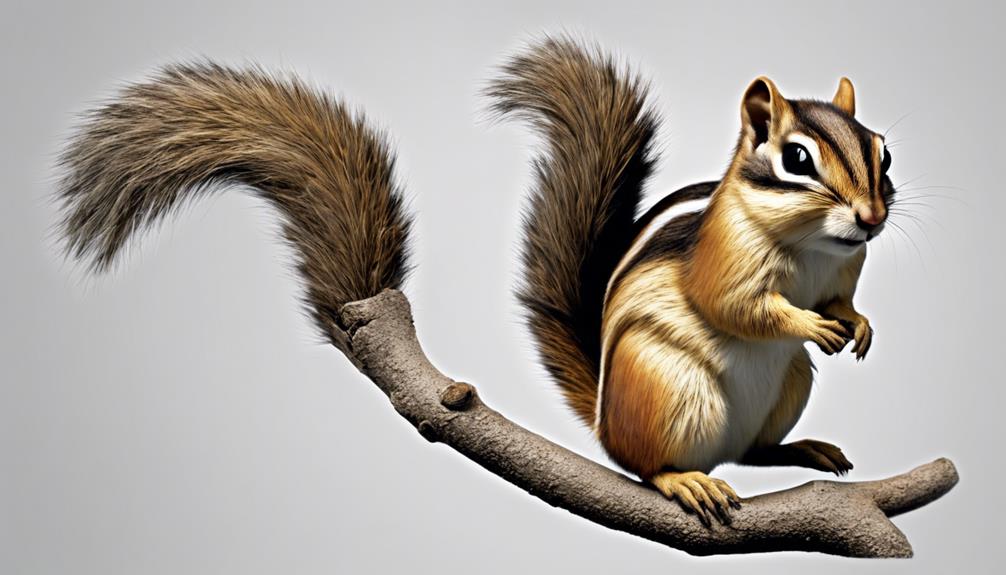
In the domain of rodent species sharing similarities with squirrels, marmots stand out for their substantial size and burrowing habits akin to those of tree-dwelling squirrels. These hoary marmots, also known as Alaska marmots, are commonly found in rocky slopes, echoing the habitats favored by many squirrel species. The marmot's resemblance to squirrels extends beyond their living arrangements, encompassing aspects of their physical appearance and behaviors.
Chipmunks, especially species like the Lodgepole chipmunks, Least Chipmunk, and Colorado chipmunk, exhibit striking similarities to squirrels with their small size, distinctive stripes, and cheek pouches for storing food. These traits closely mirror those of ground squirrels, further blurring the line between the two groups. Additionally, the Black-Tailed Prairie Dog shares squirrel-like characteristics such as a social nature, herbivorous diet, and preference for underground dwellings, reinforcing the interconnectedness of rodents resembling squirrels in various ecosystems.
Exotic Pets With Squirrel-Like Features
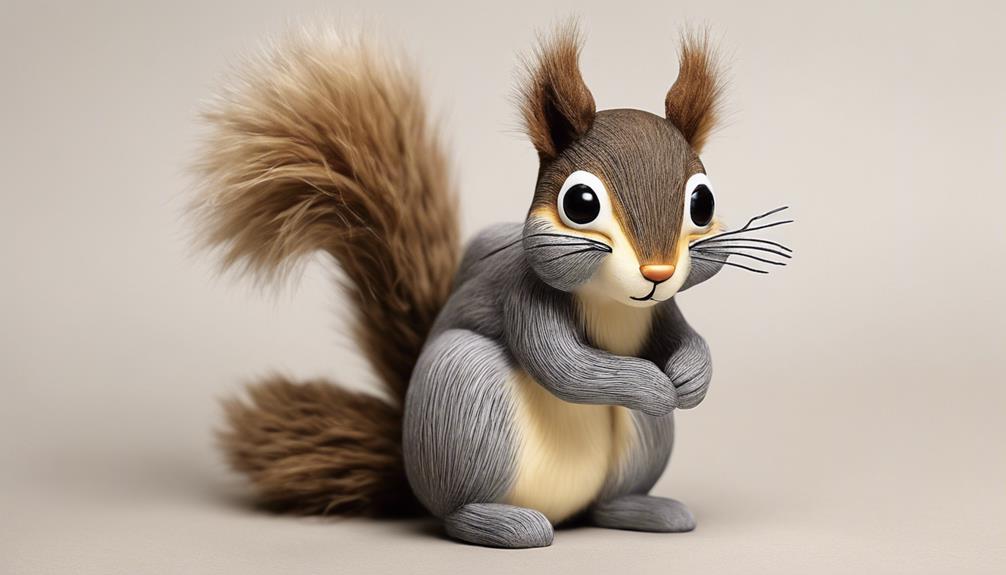
Observing the spectrum of exotic pets with squirrel-like features reveals a fascinating array of creatures that share intriguing resemblances to these nimble arboreal mammals. Among these fascinating animals are sugar gliders, Siberian chipmunks, chinchillas, and African dormice. These creatures offer unique pet options with similarities to squirrels, making them popular choices among enthusiasts.
| Exotic Pets | Resemblance to Squirrels | Unique Features |
|---|---|---|
| Sugar Gliders | Tree-dwelling marsupials with skin flaps for gliding | Active in the night |
| Siberian Chipmunks | Active during the day and live in trees | Not native to N.America |
| Chinchillas | Energetic and curious personalities similar to squirrels | Found in the Andes mountains |
| African Dormice | Small rodents with bushy tails resembling squirrels | Once popular pets in the U.S. |
These animals exhibit behaviors and physical traits that echo the charm and allure of squirrels, offering a unique experience for those looking to bring a touch of the wild into their homes.
Frequently Asked Questions
Which Animal Looks Like Squirrel?
We often observe animals resembling squirrels in various ways. From chipmunks with their stripes to prairie dogs' social behavior, and marmots' burrowing habits, nature presents a tapestry of creatures echoing the squirrel's traits.
What Animal Is Most Closely Related to Squirrels?
We observe marmots, close relatives of squirrels within the Sciuridae family. They share an evolutionary history dating back to the late Miocene Epoch. Physical traits and behaviors of marmots bear striking resemblances to squirrels, emphasizing their kinship.
What Is the Closest Thing to a Squirrel?
Well, the closest thing to a squirrel? Chipmunks! Those cheeky little critters with their food-stashing ways. They're like the squirrel's quirky cousin. Watch them scurry and stash, nature's little comedians.
What Rodent Looks Like a Small Squirrel?
We observed the question about a rodent resembling a small squirrel. The Lodgepole Chipmunk with its striped back, the Hoary Marmot's stout body, moles' velvety fur and paddled feet, and hamsters' short tails share similarities with squirrels.
Are Red Pandas Related to Squirrels in Any Way?
Yes, recognizing red panda behavior can offer some insight into their relationship with squirrels. While red pandas and squirrels are not closely related, they do share similar arboreal habitats and both are known for their agile climbing and tree-dwelling behaviors.
Conclusion
In the vast tapestry of the animal kingdom, we've uncovered creatures that mirror the charming squirrel in appearance and behavior.
From the chipmunks with their striped coats, to the marmots with their bushy tails, and even the prairie dogs with their social habits, nature has painted vivid portraits of squirrel doppelgangers.
These animals serve as reminders of the beauty and diversity that exist within our world, each one a unique thread in the intricate fabric of life.
Paul’s love for animals knows no bounds. As a dedicated writer and animal lover, Paul brings a unique perspective to our team. His firsthand experiences with various animals enrich our content and provide valuable insights into their behavior and needs. Whether he’s sharing tips for pet care or shedding light on pressing conservation issues, Paul’s passion for animals shines through in everything he does.
-

 Vetted2 months ago
Vetted2 months ago15 Best Cat Foods for Managing Hyperthyroidism – Vet Approved and Feline Friendly
-

 Vetted2 months ago
Vetted2 months ago15 Best Dog Foods for Kidney Disease – Expert Recommendations for Your Pet's Health
-

 Vetted2 months ago
Vetted2 months ago15 Best Wet Cat Foods for Older Cats to Keep Them Healthy and Happy
-

 Vetted2 months ago
Vetted2 months ago14 Best Homemade Dog Food Recipes Your Pup Will Love – Vet Approved & Nutritious
-

 Vetted2 months ago
Vetted2 months ago15 Best Fresh Dog Food Delivery Services for Your Pup's Health and Happiness
-

 Animal Facts2 months ago
Animal Facts2 months agoSpring Animals: A Guide to Seasonal Wildlife
-
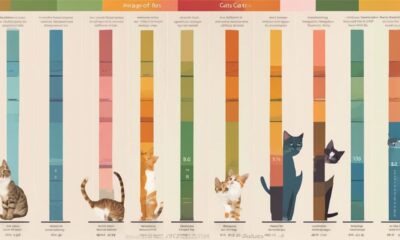
 Cats1 month ago
Cats1 month agoCat Weight Chart by Age: Kitten to Senior in Lbs
-

 Cats2 weeks ago
Cats2 weeks agoTop 5 Cat Breeders in Arkansas: A Guide





















